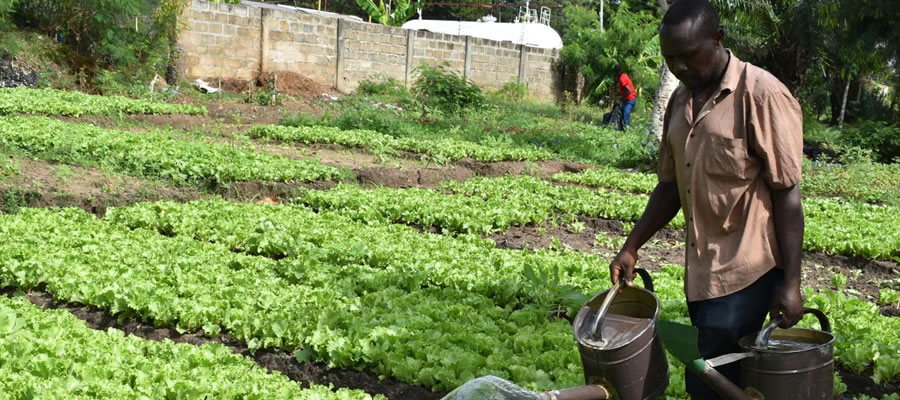

A household is classified as an agricultural household if at least one of its members engages in agricultural production even if not earning from agricultural activity alone.
The total number of households engaged in agricultural activities which are crop farming, livestock rearing, tree planting and fish farming. The Table indicates that out of 16,313 households in the district, 14,323 representing 87.8 percent of households are engaged in agriculture.
More than three quarter (83.7%) of the urban households in the district are engaged in agriculture and close to ninety-two percent (91.7%) of the rural households are also engaged in agriculture. This implies the district is agricultural. There may therefore be the need to diversify and expand other sectors in the district to create and sustain non- agricultural employment.
The 14,323 households in agriculture reported a total 19,804 agricultural activities giving an average of about 1.4. This implies that about 40.0 percent of households per activity are engaged in more than one different activity.
Also, the most predominant traditional activities in the district are crop farming and livestock rearing both in urban and rural the communities. Fish farming as distinct from fishing is relatively new in the district with only a small percentage (0.1%) of agricultural households engaged in it. This could be to the fact that the start -up capital for initial investment is relatively high.
Tree planting is also not a traditional activity and attracted less than two percent (1.8%) of the total agricultural households. Tree planting in particular requires a considerable waiting time to harvest. This is not likely to draw much interest from the substantially subsistent level of agricultural communities of the district.
More households in rural areas (47.1%) rear livestock than those in urban areas (26.9%). There is no significant difference between rural and urban households in the non-traditional activities of tree planting and fish farming.
Livestock and keepers
Livestock rearing is the second most important agricultural activity in Tain District. It occurs throughout the district, and in both rural and urban areas. The top two among the ruminants are goat (28,783 or 18.8%), sheep (14,049 or 9.2%) and cattle (1,527 or 1.0%). The only monogastric animal (pig) in the district also records 2,779 or 1.8 percent of all the livestock.
In the bird category, there are 98,221 chicken (64.1%), 2,947 guinea fowls (1.9%) and 1,490 ducks (1.0%) of all the livestock. Among the other livestock (non-traditional livestock), reported grass-cutters and rabbits are 192 and 160 (0.2% of all the livestock).
Inland fishing (14 baskets), marine fishing (20 baskets) and silk worm (82 baskets) remain the least form of livestock in the district.
Majority of livestock keepers rear chickens (46.1%) with an average of 25 chickens per keeper. About thirty percent of keepers (30.2%) rear goats with an average of 11 goats per keeper. In addition, keepers for sheep make up 15.7 percent of keepers. The average sheep per keeper is 10. The average fingerling per keeper for fish farming is 335 while inland fishing is 7 baskets. The average animal per keeper for snail is (45) followed by ostrich (26).
Food security
The issue of food insecurity is not a prevailing problem in the District since it is an agrarian economy. The District is able to produce enough for the inhabitants within and to the extent of exporting some of the food products outside the District. One major crop being cultivated in the District and which becomes very abundant during the bumper season is yam with 10.4% as annual total produce level. Other food crops which are produced in the district with annual total produce level are pepper-5.1%; cassava- 6.2%; cocoyam-2.3%; pepper 5.1%; groundnut-5.1%; cowpea-4.4% and plantain-5.3%.
Apart from these food crops, the District is also a major producer of cashew for export. During the bumper harvest, the food items become very affordable. This means the district should facilitate the construction storage facilities to store the surplus to ensure availability of food throughout the year. Also, in order to ensure all year round food availability; the District should encourage the establishment of Small and Medium Scale Enterprises by private individuals as for value addition.
Date Created : 11/20/2017 6:17:00 AM












 facebook
facebook
 twitter
twitter
 Youtube
Youtube
 +233 593 831 280
+233 593 831 280 0800 430 430
0800 430 430 GPS: GE-231-4383
GPS: GE-231-4383 info@ghanadistricts.com
info@ghanadistricts.com Box GP1044, Accra, Ghana
Box GP1044, Accra, Ghana